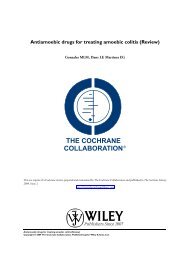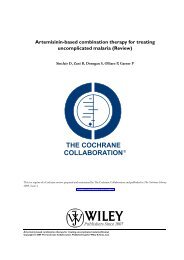Interventions for treating proximal humeral fractures in adults (Review)
Interventions for treating proximal humeral fractures in adults (Review)
Interventions for treating proximal humeral fractures in adults (Review)
You also want an ePaper? Increase the reach of your titles
YUMPU automatically turns print PDFs into web optimized ePapers that Google loves.
Stable<strong>for</strong>th 1984<br />
Methods Method of randomisation: unknown, “randomly selected”<br />
Assessor bl<strong>in</strong>d<strong>in</strong>g: unlikely<br />
Loss to follow up at 18 months to 12 years: 2/32 (2 deaths)<br />
Participants Bristol Royal Infirmary, Bristol, UK<br />
32 patients with displaced 4 part <strong>proximal</strong> <strong>humeral</strong> <strong>fractures</strong> (Neer).<br />
25 female, 7 male; mean age 68 years, range 52-88 years<br />
<strong>Interventions</strong> <strong>Interventions</strong> started: with<strong>in</strong> 5 days <strong>for</strong> surgery.<br />
(1) Neer prosthesis, uncemented<br />
(2) Closed manipulation<br />
All placed <strong>in</strong> sl<strong>in</strong>g, mobilisation of hand encouraged, shoulder flexion rotation exercises after 2-3 days.<br />
Supervised physiotherapy <strong>for</strong> 3-6 months.<br />
Assigned: 16/16<br />
Completed (at 1 year): 15/15<br />
Outcomes Length of follow up: stated as 18 months to 4 years; but also assessed regularly up to 6 months<br />
Dependent <strong>in</strong> activities of daily liv<strong>in</strong>g<br />
Range of motion (flexion, medial rotation, lateral rotation)<br />
Pa<strong>in</strong><br />
Muscle strength (flexion, abduction, lateral rotation)<br />
Complications: haematoma, cellulitis, deep sepsis, early shoulder stiffness<br />
Mortality<br />
Notes<br />
Risk of bias<br />
Item Authors’ judgement Description<br />
Allocation concealment? Unclear B - Unclear<br />
Wirbel 1999<br />
Methods Method of randomisation: unknown, “random allocation”<br />
Assessor bl<strong>in</strong>d<strong>in</strong>g: unlikely<br />
Loss to follow up at 6 months: 13/77; also 14 months (9 to 36 months): 18/77<br />
Participants University Hospital, Homburg/Saar, Germany<br />
77 patients with displaced (separation exceeds 1 cm; fragment angulation > 30 degrees, or when tuberosity<br />
fragment is separated by > 3 mm) subcapital <strong>humeral</strong> <strong>fractures</strong> of type A1, A3, B and C1 (modified AO<br />
classification) treated by closed reduction and percutaneous fixation.<br />
Excluded: Extensive local sk<strong>in</strong> <strong>in</strong>fection. Impacted <strong>fractures</strong> of type A2 (treated conservatively). Not fit<br />
enough to undergo anaesthesia and X-ray of affected shoulder <strong>in</strong> anterior-posterior plane. Closed reduction<br />
not feasible.<br />
54 female, 23 male; mean age 63 years, range 6-89 years<br />
<strong>Interventions</strong> <strong>for</strong> <strong>treat<strong>in</strong>g</strong> <strong>proximal</strong> <strong>humeral</strong> <strong>fractures</strong> <strong>in</strong> <strong>adults</strong> (<strong>Review</strong>)<br />
Copyright © 2008 The Cochrane Collaboration. Published by John Wiley & Sons, Ltd.<br />
27








